Archive for the 'Fruit' Category

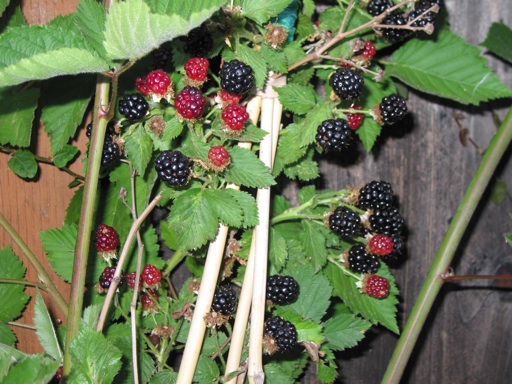
Last summer, I discovered this blackberry plant at a local nursery. It’s a thornless blackberry variety called Navaho. I planted it in a container with a standard potting soil, and I put the container next to a fence to help support its vines. Its vines are more erect then the vines of my raspberry plants (which I am also growing in containers) and do not seem to need much support. I have an automatic microspray device on it that waters it every other day.
Wild blackberries grow in some parts of our yard, and I am constantly digging them up in an attempt to get rid of them. The thorns on these wild blackberries are nasty. They poke right through my thickest gloves. So I was excited to discover that there are hybrid varieties of thornless blackberries. What a pain it is to harvest berries from thorny vines while constantly getting poked! I didn’t even consider planting blackberries until I discovered this thornless variety. It turns out there are several other thornless blackberry varieties.
The wild blackberries in our yard are invasive. They spread by underground runners, which makes them hard to control. I have tried pulling them up by the roots several times, but they keep growing back every year. I decided to plant the Navaho blackberry in a container, in order to prevent it from spreading the way blackberries tend to do.
Navaho is an early ripening variety. Most of its berries are ready to be picked in late June and early July. I do not like tart blackberries, but I’ve found there is a way to harvest sweet blackberries. The berries are ripe and very sweet when they come off the vine easily with only a slight tug. The berries on my Navaho are usually quite tart until they come off the vine easily. Then they are really sweet, tasting the way blackberries are supposed to taste. If I need to pull firmly to get a blackberry off the vine, it usually too tart.
I rarely buy blackberries in supermarkets, because they are typically too tart for my tastes. I’ve noticed that the sweetest of our blackberries are often soft and sometimes even on the verge of falling apart. Soft berries probably don’t ship well, and I imagine that’s why supermarket blackberries are picked early when they are very firm but tart. More reason to grow your own.
July 01 2012 | Blackberries | Comments Off on Thornless Blackberry in a Container
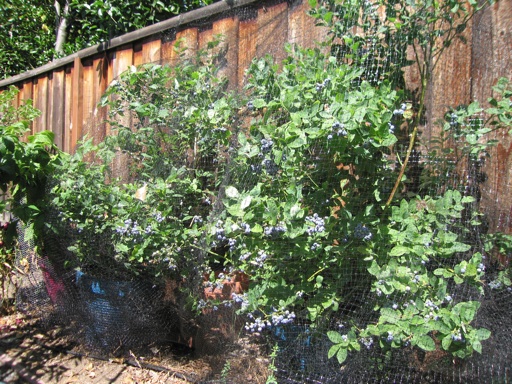
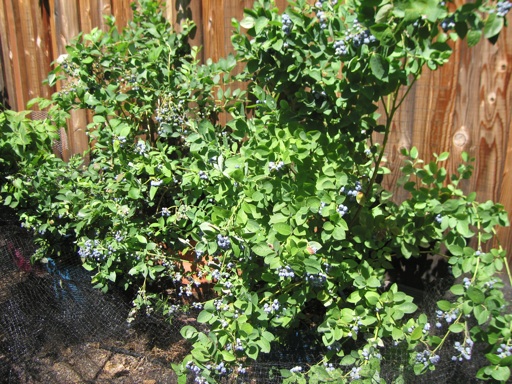
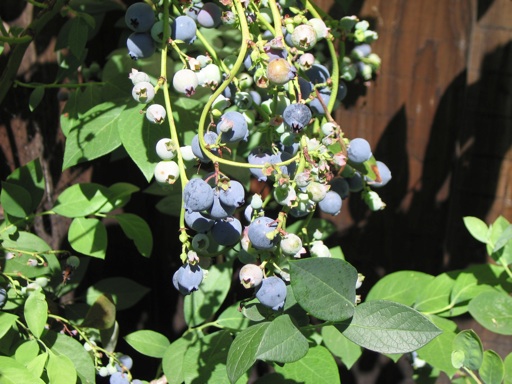
I have been growing blueberry plants in our backyard for about five years. Our blueberry harvest season runs from mid-May to late July, with June being the peak of the harvest. Every year they have been producing more berries. This morning, I harvested about 3 pints of blueberries just from the two plants in the pictures above.
All of our blueberry plants are covered with netting to reduce the number of berries that the birds eat. Each plant is covered with 3-4 layers of netting, because birds will eat through just one or two layers of netting.
My favorite way to grow blueberries is in pots. I transplanted the two plants shown in the pictures above into pots about 3 years ago. I planted them in a potting mix of about 1/3 bark, 1/3 peat moss, and 1/3 acid potting mix per Dave Wilson’s suggestion, and they have been growing and producing well. Although, the blueberry plants I have in the ground are growing and producing well too. I like growing them in pots though, because they are easier to net and harvest (less squatting). Also, growing them next to a fence makes netting a bit easier.
I am growing five different Southern Highbush varieties of blueberries that are adapted to mild winter climates. The five varieties I have are Southmoon, Jubilee, O’Neal, Sunshine Blue, and Misty. I have one plant of each variety. The two plants shown in the pictures above are Southmoon and Jubilee. My favorite varieties are Southmoon and O’Neal. My Southmoon and O’Neal plants produce the largest and tastiest berries of the 5 plants I have. My Jubilee plant produces the most berries, but they tend to be small and on the tart side, and they start to wrinkle if left on the plant too long. Misty also produces lots of small berries, although some of them are medium size.
Sunshine Blue is my third favorite variety. Its berries are a variety of sizes (large to small), and they taste very good if they are not picked too soon. Typically, the berries of all 5 varieties (particularly Misty, Sunshine and Jubilee) have to be left on the bush for several days after turning blue before they reach an ideal sweetness. Also, Sunshine Blue is a late ripening blueberry. It ripens throughout July in our yard, which is nice because it extends the harvest season an extra month.
June 16 2012 | Blueberries | Comments Off on Blueberry Harvest
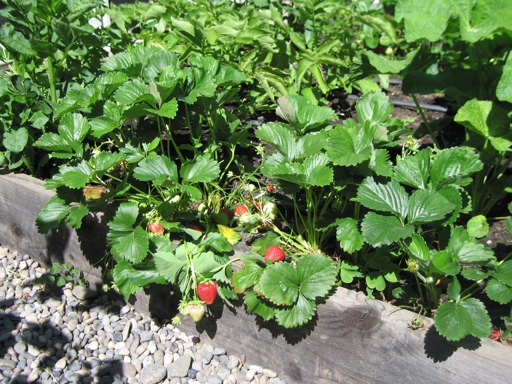
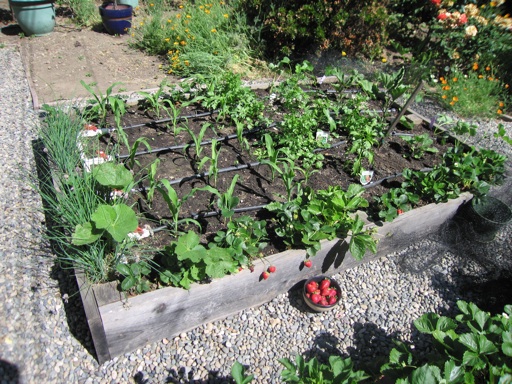
When I last posted about strawberries back in 2009, I was still growing most of our strawberries in pots. Back then, I was having problems with slugs eating the berries at night and hiding under the pots in the daytime. Copper tape and beer didn’t stop them. So over the past few years, I have been phasing out the berries growing in pots. Last year, I planted new strawberry plants as a border around each of our 4 raised beds. I planted the varieties Sequoia, Seascape, and Chandler.
They didn’t produce many berries their first year. However, starting around May 1 this year, they finally started producing a lot of berries. I have been harvesting about 4 pint size bowls of berries per week for each of the past 3 weeks. The most productive variety by far this year is Chandler. Our Chandler strawberry plants are producing many large berries, from only about a dozen plants. The Chandler berries are large and firm and don’t rot or turn brown quickly (first picture above). I have been fertilizing our strawberries about once every 2 weeks.
I have at least two dozen Sequoia strawberry plants. The Sequoia strawberries have lots of leaves, but they haven’t been as productive as the Chandler strawberries. I am not sure why the Sequoias haven’t been producing as much as they did in the past when I grew them in pots. I still have a few newer Sequoias in pots, and they aren’t producing many berries either. Also, the Sequoia berries tend to be small (many of them are very small) and often the berries start to turn brown or rot on one side before they are fully ripe. In my opinion, the Sequoia strawberries have the best flavor of these three varieties, assuming they are fully ripe, not too small, and not browning yet, which eliminates at least half of the harvest.
For now, Chandler is my favorite variety. I prefer plants that produce lots of large berries as opposed to few small ones. Just this week, I planted more Chandler strawberries plants that I purchased from a local nursery.
The Seascape strawberries are large and firm like the Chandler strawberries, but they haven’t been as productive as Chandler. Seascape is an ever bearing variety, which tends to produce more berries in the summer. Chandler and Sequoia are long day varieties, which tend to produce the most berries from mid-spring to early summer.
As for the slugs and snails, they still eat a few of the berries in the raised beds, but it’s easier to protect them with Sluggo and netting than when they were crowded into pots.
May 20 2012 | Strawberries | Comments Off on Strawberries
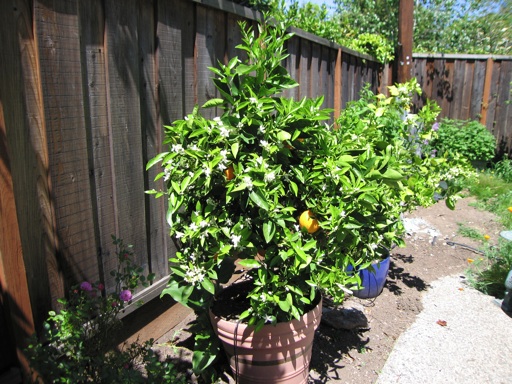
This is a photo of a Washington navel orange bush that I used to have growing in the ground. It is the same plant that I wrote about in a post two years ago complaining how it was dropping leaves when I fertilized it. I later talked to a citrus grower who convinced me that it was dropping leaves, because I watered it too much after I fertilized it. I didn’t think I was overwatering it, but it occurred to me that the ground there may not be draining quickly because of its clay-like soil. I figured our orange didn’t like that spot, because when I did irrigate it, the water may have been sitting there too long.
So I dug the plant up and transferred it to a large container. Since I moved it to the container, it has thrived. It hasn’t dropped leaves like it did when it was growing it the ground. Instead, it has grown considerably, and its leaves are a healthy looking dark green color. Just in the past few weeks, it has developed a flush of new green growth, and it is full of blossoms. It also has about 10 large fruits on it that are nearly ripe. It obviously likes being in the pot better than in the ground, and I think it’s because the pot drains water more effectively. Although, it does need more frequent watering in the container.
I also have a small page mandarin orange bush that I had growing in the ground in a different part of our yard for a few years. While it was in the ground, it often dropped many of its leaves like the orange. It also had many yellow leaves even after fertilizer applications, and it didn’t grow much. Last year, I transplanted it to a container. Since then, I’ve noticed it improving. It’s growing more, it’s not dropping leaves, and its leaves are much greener now than they were when it was growing in the ground. It’s also just beginning to bloom now.
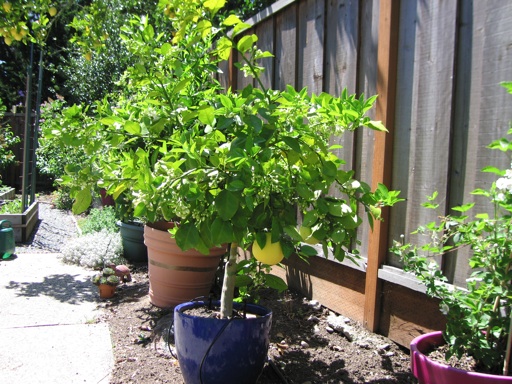
This is a photo of an Oroblanco citrus bush we have growing in yet another container. We bought it from a nursery just over a year ago. It has two fruits on it, which I am anxious to taste. So far it also seems to be doing well in a pot.
Last winter, the temperature here dropped down to 26.5 F on two nights, but none of our citrus plants had any noticeable signs of freeze damage. Even the three citrus bushes we have in pots which were outside and uncovered didn’t show any damage from the freezing weather. So far, the orange fruits I have picked are also not showing freeze damage. Cold damaged citrus typically has dried out pulp.
April 21 2012 | Oranges and Oroblanco | Comments Off on Citrus in Containers
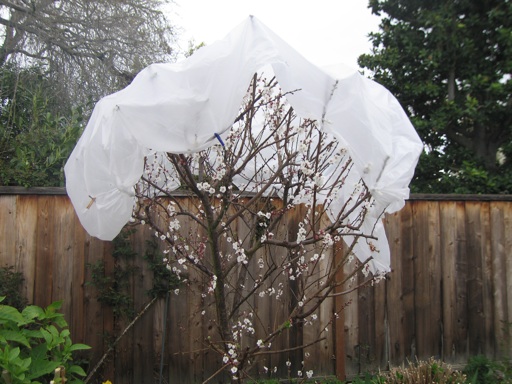
Last year, I did not harvest a single fruit from our Blenheim apricot tree. After a week or 2 of heavy rains in March 2011, the newly forming fruits were covered with mildew. Sometime later, they fell off.
This year, I am determined not to let rain ruin my apricot crop a second year in a row. So two weeks ago, when I heard that a week or more of rain was in our forecast, I decided to try an unconventional approach. I read on a website that some people cover their fruit trees to protect them from heavy rains. So I decided to give this technique a try.
Above is a picture of our apricot tree after we covered it with a clear plastic drop cloth. I used a .7 mil thick drop cloth that I purchased in the paint section of local big box home improvement store. I attached the drop cloth to the branches of the tree with clothes pins. I selected a thin drop cloth, because I wanted it to be easy to drape over the tree and light enough not to damage the blossoms. Getting the drop cloth on the tree was a challenge. We used a ladder and a pruning pole to drape the cloth over the tree and then spread it out. Our tree is only about 8-9 feet tall, because I prune it a lot. Trying to drape a drop cloth over a large tree would probably be impractical. The drop cloth stayed on the tree for a week through several days of rain including one night of heavy downpours. Last weekend, strong winds ripped it to shreds.
I left the apricot tree uncovered this past week, because we had dry weather. So far, it looks like the drop cloth was successful. Several small apricot fruits have already formed, and there is no sign of mildew on them.
However, a few days ago our weather forecasters predicted several more days of rain starting today. I think once most of the fruits have set they can survive the rain, but I don’t think they are there yet. Many of the apricot blossoms have just dropped their petals and have not formed fruit yet. That seems to be the time when they are most vulnerable to being knocked off by heavy rain or getting mildew after being exposed to several days of damp weather.
I covered our apricot tree again yesterday afternoon with a new clear drop cloth. This time I used a 1 mil 10′ x 20′ drop cloth, hoping the extra thickness would make it less prone to being torn by the wind. I also covered our multi-grafted pluot tree, which was easy to do because it’s so small (see picture below).

March 24 2012 | Apricots | Comments Off on Fruit Tree Umbrella
« Prev - Next »










